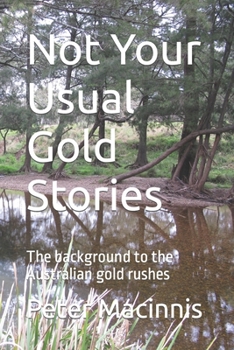Not Your Usual Gold Stories: The background to the Australian gold rushes
All Australian children are given an account of the chase for gold in Australia that runs like this: Nobody knew there was gold in Australia, Edward Hammond Hargraves discovered gold in New South Wales in 1851, and then the rushes began.This is false history. The first claim of a 'gold mine' was a fraud in 1788; the first real gold find was in 1824; the first working gold mine was in South Australia in 1843; a shepherd, Hugh M'Gregor regularly sold gold in Sydney in the 1840s; the first gold rush was in Victoria in 1849, but the authorities choked it off; and Hargraves never discovered gold.What Hargraves did was to provoke a gold rush that could not be stopped, by declaring that there was gold over wide area, stretching from the site of the 1824 find to where M'Gregor was collecting gold.This book details all of those matters, and many more, explaining the psychology of gold rushes, the technicalities of finding gold, and the true costs of gold fever. While it mainly deals with the Australian situation, there are many comparisons with overseas situations, from Prague, the Middle East and the Americas: this is a world history with a strong Australian bias.It is also a starting point for scholars, because the sources are meticulously recorded, and at last count, there were 236 web links, because in this increasingly internet-crazy world, people want those links to books and contemporary newspaper accounts.
Format:Paperback
Language:English
ISBN:198309207X
ISBN13:9781983092077
Release Date:June 2018
Publisher:Independently Published
Length:234 Pages
Weight:0.70 lbs.
Dimensions:0.5" x 6.0" x 9.0"
Related Subjects
HistoryCustomer Reviews
0 rating





